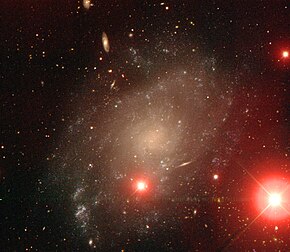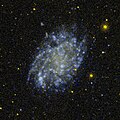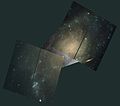| Revision as of 22:07, 11 September 2023 editOnel5969 (talk | contribs)Autopatrolled, Extended confirmed users, Page movers, New page reviewers, Pending changes reviewers, Rollbackers937,500 editsm Reverted edit by Onel5969 (talk) to last version by OAbotTag: Rollback← Previous edit | Latest revision as of 06:49, 31 August 2024 edit undoPhantomdj (talk | contribs)Extended confirmed users2,449 editsm spacing | ||
| (6 intermediate revisions by 3 users not shown) | |||
| Line 4: | Line 4: | ||
| | name = {{PAGENAME}} | | name = {{PAGENAME}} | ||
| | image = File:NGC 45 DECam.jpg | | image = File:NGC 45 DECam.jpg | ||
| | image_size =250 | |||
| | upright = | | upright = | ||
| | caption = NGC 45 by ] | | caption = NGC 45 by ] | ||
| Line 35: | Line 34: | ||
| | xray_radius_arcminsec = <!-- apparent dimension --> | | xray_radius_arcminsec = <!-- apparent dimension --> | ||
| | notes = | | notes = | ||
| | names = {{odlist | UGCA=4 | MCG=04-01-21 | PGC=930 | LEDA=930 }}<ref name=SIMBAD/> | | names = {{odlist | UGCA=4 | MCG= -04-01-21 | PGC=930 | LEDA=930 }}<ref name=SIMBAD/> | ||
| | references = | | references = | ||
| }} | }} | ||
| Line 45: | Line 44: | ||
| Unlike the Milky Way, NGC 45 has no clearly defined ]s, and its ] is also very small and distorted. NGC 45 thus does not have a ].<ref name=Gowanlock_et_al_2011/><ref name=gowanlock-2011/><ref name="SP-20150821"/> For the Milky Way, the galactic habitable zone is commonly believed to be an ] with an outer radius of about 10 ]s and an inner radius close to the ], both of which lack hard boundaries.<ref name=gowanlock-2011 /> | Unlike the Milky Way, NGC 45 has no clearly defined ]s, and its ] is also very small and distorted. NGC 45 thus does not have a ].<ref name=Gowanlock_et_al_2011/><ref name=gowanlock-2011/><ref name="SP-20150821"/> For the Milky Way, the galactic habitable zone is commonly believed to be an ] with an outer radius of about 10 ]s and an inner radius close to the ], both of which lack hard boundaries.<ref name=gowanlock-2011 /> | ||
| ==Astronomical Transients== | |||
| On 22 May 2018 a ] was detected within NGC 45 and was subsequently labeled AT 2018bwo. Luminous red novae like this are thought to be the result of stars merging. The progenitor of AT 2018bwo was a ] star.<ref name=Klencki_et_al_2021/> | |||
| Two ] have been observed in NGC{{nbsp}}45. On 22 May 2018 a ] was detected and subsequently labeled AT{{nbsp}}2018bwo (type LRN, mag. 16.4).<ref>{{cite web | website=Transient Name Server | title=AT{{nbsp}}2018bwo | url=https://www.wis-tns.org/object/2018bwo | publisher = ] | access-date=30 August 2024}}</ref> Luminous red novae are thought to be the result of stars merging. The progenitor of AT{{nbsp}}2018bwo was a ] star.<ref name=Klencki_et_al_2021/> A few months later, on 3 November 2018, a ] was discovered and designated AT{{nbsp}}2018htr (type LBV, mag. 17.5).<ref>{{cite web | website=Transient Name Server | title=AT{{nbsp}}2018htr | url=https://www.wis-tns.org/object/2018htr | publisher = ] | access-date=30 August 2024}}</ref> | |||
| == Gallery == | == Gallery == | ||
| Line 52: | Line 52: | ||
| File:NGC45--hst-606-r814g555b435.jpg|] mosaic of NGC 45 | File:NGC45--hst-606-r814g555b435.jpg|] mosaic of NGC 45 | ||
| </gallery> | </gallery> | ||
| == See also == | |||
| * ] | |||
| ==References== | ==References== | ||
| Line 116: | Line 119: | ||
| | volume=153 | page=6 | year=2016 | | volume=153 | page=6 | year=2016 | ||
| | issue=1 | arxiv=1611.02574 | doi=10.3847/1538-3881/153/1/6 | | issue=1 | arxiv=1611.02574 | doi=10.3847/1538-3881/153/1/6 | ||
| | s2cid=119388974 | bibcode=2017AJ....153....6K }}</ref> | | s2cid=119388974 | bibcode=2017AJ....153....6K | doi-access=free }}</ref> | ||
| <ref name=Tully_et_al_2016>{{cite journal | <ref name=Tully_et_al_2016>{{cite journal | ||
| Line 125: | Line 128: | ||
| | volume=152 | issue=2 | id=50 | pages=21 | date=2016 | | volume=152 | issue=2 | id=50 | pages=21 | date=2016 | ||
| | bibcode=2016AJ....152...50T | arxiv=1605.01765 | | bibcode=2016AJ....152...50T | arxiv=1605.01765 | ||
| | doi=10.3847/0004-6256/152/2/50 | s2cid=250737862 }}</ref> | | doi=10.3847/0004-6256/152/2/50 | s2cid=250737862 | doi-access=free }}</ref> | ||
| <ref name=Cook_et_al_2014>{{cite journal | <ref name=Cook_et_al_2014>{{cite journal | ||
| Line 137: | Line 140: | ||
| | year=2014 | volume=445 | issue=1 | page=881 | | year=2014 | volume=445 | issue=1 | page=881 | ||
| | bibcode=2014MNRAS.445..881C | arxiv=1408.1130 | | bibcode=2014MNRAS.445..881C | arxiv=1408.1130 | ||
| | doi=10.1093/mnras/stu1580 | s2cid=118399317 }}</ref> | | doi=10.1093/mnras/stu1580 | doi-access=free | s2cid=118399317 }}</ref> | ||
| <ref name=ned>{{cite web | <ref name=ned>{{cite web | ||
| Line 201: | Line 204: | ||
| ] | ] | ||
| ] | ] | ||
| ] | ] | ||
| ] | ] | ||
| ] | ] | ||
| ] | ] | ||
| ] | ] | ||
| ] | |||
| ] | |||
Latest revision as of 06:49, 31 August 2024
Spiral galaxy in the constellation Cetus
| NGC 45 | |
|---|---|
 NGC 45 by DECam NGC 45 by DECam | |
| Observation data (2000.0 epoch) | |
| Constellation | Cetus |
| Right ascension | 00° 14′ 03.989″ |
| Declination | –23 10 55.53 |
| Redshift | 0.001558 |
| Heliocentric radial velocity | 466 km/s |
| Distance | 21.7 Mly (6.64 Mpc) |
| Apparent magnitude (V) | 10.73±0.03 |
| Apparent magnitude (B) | 11.21±0.03 |
| Characteristics | |
| Type | SA(s)dm |
| Mass/Light ratio | M☉/L☉ |
| Apparent size (V) | 7.41′ × 5.13' |
| Other designations | |
| UGCA 4, LEDA 930, MCG -04-01-21, PGC 930 | |
NGC 45 is a low surface brightness spiral galaxy in the equatorial constellation of Cetus. It was discovered on 11 November 1835 by the English astronomer John Herschel. The galaxy is located at a distance of 22 million light years and is receding with a heliocentric radial velocity of 466 km/s. It is located in the vicinity of the Sculptor Group, but is most likely a background galaxy.
The morphological class of NGC 45 is SA(s)dm, indicating this is a spiral galaxy with no prominent inner bar (SA) or ring (s) feature. There is no central bulge to speak of. The galactic plane is inclined at an angle of 55°±5° to the line of sight from the Earth, with the major axis of the elliptical profile being aligned along a position angle of 145°±5°. Star formation is proceeding at a modest rate of ~0.20 M☉·yr.
Unlike the Milky Way, NGC 45 has no clearly defined spiral arms, and its center bar nucleus is also very small and distorted. NGC 45 thus does not have a galactic habitable zone. For the Milky Way, the galactic habitable zone is commonly believed to be an annulus with an outer radius of about 10 kiloparsecs and an inner radius close to the Galactic Center, both of which lack hard boundaries.
Astronomical Transients
Two astronomical transients have been observed in NGC 45. On 22 May 2018 a luminous red nova was detected and subsequently labeled AT 2018bwo (type LRN, mag. 16.4). Luminous red novae are thought to be the result of stars merging. The progenitor of AT 2018bwo was a yellow supergiant star. A few months later, on 3 November 2018, a luminous blue variable was discovered and designated AT 2018htr (type LBV, mag. 17.5).
Gallery
-
 Galex (ultraviolet) view of NGC 45
Galex (ultraviolet) view of NGC 45
-
 Hubble mosaic of NGC 45
Hubble mosaic of NGC 45
See also
References
- ^ Skrutskie, Michael F.; et al. (1 February 2006). "The Two Micron All Sky Survey (2MASS)". The Astronomical Journal. 131 (2): 1163–1183. Bibcode:2006AJ....131.1163S. doi:10.1086/498708. ISSN 0004-6256. S2CID 18913331.
- "NGC 0045". NASA NED. Retrieved 20 April 2010.
- ^ Tully, R. Brent; et al. (2016). "Cosmicflows-3". The Astronomical Journal. 152 (2): 21. arXiv:1605.01765. Bibcode:2016AJ....152...50T. doi:10.3847/0004-6256/152/2/50. S2CID 250737862. 50.
- ^ Karachentsev, Igor D.; et al. (2016). "The Local Tully–Fisher Relation for Dwarf Galaxies". The Astronomical Journal. 153 (1): 6. arXiv:1611.02574. Bibcode:2017AJ....153....6K. doi:10.3847/1538-3881/153/1/6. S2CID 119388974.
- ^ Cook, David O.; et al. (2014). "The Spitzer Local Volume Legacy (LVL) global optical photometry". Monthly Notices of the Royal Astronomical Society. 445 (1): 881. arXiv:1408.1130. Bibcode:2014MNRAS.445..881C. doi:10.1093/mnras/stu1580. S2CID 118399317.
- ^ Pannuti, Thomas G.; et al. (September 2015). "Chandra and Very Large Array Observations of the Nearby Sd Galaxy NGC 45". The Astronomical Journal. 150 (3): 16. Bibcode:2015AJ....150...91P. doi:10.1088/0004-6256/150/3/91. S2CID 38143095. 91.
- ^ Chemin, Laurent; et al. (December 2006). "H I Studies of the Sculptor Group Galaxies. VIII. The Background Galaxies: NGC 24 and NGC 45". The Astronomical Journal. 132 (6): 2527–2538. arXiv:astro-ph/0609148. Bibcode:2006AJ....132.2527C. doi:10.1086/508859. S2CID 947116.
- "NGC 45". SIMBAD. Centre de données astronomiques de Strasbourg.
- Seligman, Courtney. "NGC Objects: NGC 1 - 49". Celestial Atlas. Retrieved 26 December 2021.
- de Vaucouleurs, G. "II. MORPHOLOGY, #34". Classification and Morphology of External Galaxies. Retrieved 26 December 2021.
- ^ Gowanlock, M. G.; et al. (2011). "A Model of Habitability Within the Milky Way Galaxy". Astrobiology. 11 (9): 855–873. arXiv:1107.1286. Bibcode:2011AsBio..11..855G. doi:10.1089/ast.2010.0555. PMID 22059554. S2CID 851972.
- Choi, Charles Q. (21 August 2015). "Giant Galaxies May Be Better Cradles for Habitable Planets". Space.com. Retrieved 24 August 2015.
- "AT 2018bwo". Transient Name Server. IAU. Retrieved 30 August 2024.
- Blagorodnova, Nadejda; et al. (2021). "The luminous red nova AT 2018bwo in NGC 45 and its binary yellow supergiant progenitor". Astronomy & Astrophysics. 653: A134. arXiv:2102.05662. Bibcode:2021A&A...653A.134B. doi:10.1051/0004-6361/202140525. S2CID 231879751.
- "AT 2018htr". Transient Name Server. IAU. Retrieved 30 August 2024.
External links
- Revised NGC Data for NGC 45
 Media related to NGC 45 at Wikimedia Commons
Media related to NGC 45 at Wikimedia Commons- NGC 45 on WikiSky: DSS2, SDSS, GALEX, IRAS, Hydrogen α, X-Ray, Astrophoto, Sky Map, Articles and images
| Astronomical catalogs | |
|---|---|
| NGC | |
| PGC | |
| UGC | |